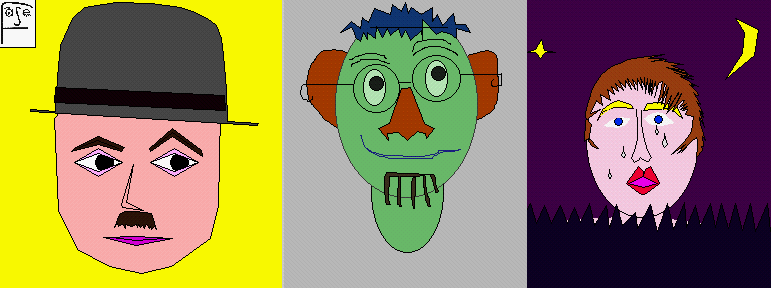
Face Editor is a drawing program for the construction of 2D drawings which can be animated (see figure). Face Player is a movieplayer which can play those animations, assuming time varying animation parameters are also provided (see for instance the Animation Editor program).
In Face Editor, one constructs a drawing by selecting
and dropping components. Components are specified by
fixed points, control points and an origin. (see figure).
The origin can be either fixed or animated. For control points
(and an animated origin) one can set the control range
(indicated by a cross).
The program provides a hierarchy of drawing components which
are accessed by selection from a palette (see figure).

There are basic building blocks: polygons, polylines and ellipses which either remain fixed or can be animated via control points. At the next level there are objects composed of animated polygons and other ones which change shape according to some general principles when the former do. These components can simulate objects with a moving skeleton or things like a human mouth where the outer mouth contour is explicitely animated and the inner contour follows the outer one. At the high end there are ready-made complex objects like an eye with pupil and eyelids. Finally, there is also the possibility to include images into the drawing and to make crude free-hand sketches. Every component can be edited by, for instance, adding, deleting or displacing points, setting the range of control points etc. (see figure). While editing, objects preserve their type, i.e. fixed objects remain fixed, opaque ones remain opaque etc.
Face Player is the movieplayer to be used in conjunction with Face Editor. Every drawing component included by Face Editor runs in a separate thread in Face Player. That gives the possibility to control (i.e. animate) different parts of the drawing by disjunct processes. But because drawing order is important (one wants the eyelid to be draw on top of the eyeball and not be hidden by it) components have a rank. Those with lower rank are drawn before those with a higher one. In addition the drawing can have two layers, a background image (only containing fixed components) which is generated only once during animation and an animated foreground one. FaceEditor is used to assign components there layer and rank (see figure).
The Face Editor and the Face Player are written in Java 1.1, allowing platform-independent as well as Internet applications.
They are coupled with the AnimationEditor together functioning as a 2D facial animation editing environment, called CharToon (see architecture).
For this project contact: Han Noot or Zsófia Ruttkay.
For a totally redesigned commercial version of CharToon, contact Paul ten Hagen at Epictoid for further information.
Contact Han Noot for further information.